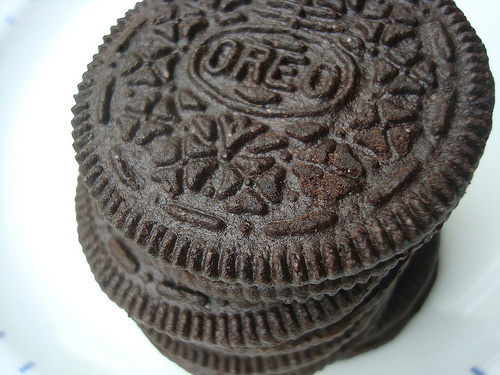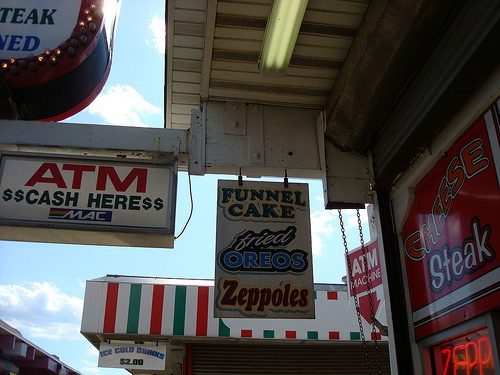 Best use of Oreos: as a s'mores base!Dear CakeSpy,
Best use of Oreos: as a s'mores base!Dear CakeSpy,
First off, I'd like to suggest that you start a column called "Ask CakeSpy". First question: How are oreos made? I've been contemplating this for a while.
Sweetly Inquisitive in Santa Cruz
- - - - - - - -
Dear Sweetly Inquisitive,
Do you want the short answer or the long one? How 'bout both?
As for the actual production process, no, they're not made from the leftover bits of other cookies, as one urban legend would have you believe. As I discovered,
According to a statement from Kim McMiller, an Associate Director of Consumer Relations, a two-stage process is used to make Oreo cookies. The base cake dough is formed into the familiar round cookies by a rotary mold at the entrance of a 300-foot-long oven. Much of current Oreo production is done at the Kraft/Nabisco factory in Richmond, Virginia.
and also, as for the design, it is "stamped out by brass rollers passing over sheets of chocolate dough". (source: NY Times)
However, if you want to get a little more philosophical about how it is that Oreos came to exist, well, let's touch on that too.
When was it invented? The Oreo, which was originally known as the Oreo Biscuit, made its debut in 1912 from the Nabisco Company in NYC (now the site of the Chelsea Market, btw).
 Where does the name come from? Per Wikipedia,
Where does the name come from? Per Wikipedia,
Oreo comes from the Greek root for appetizing as in orexin or orexigenic (appetite stimulating) or anorexic (loss of appetite). There are many theories pointing to the origin of the name 'Oreo', including derivations from the French word 'Or', meaning gold (as early packaging was gold), or the Greek word 'Oros', meaning mountain or hill (as the original Oreo was mound shaped) or even the Greek word 'Oreo', meaning beautiful or nice. Other theories are that the 're' from cream was 'sandwiched' between the two Os from cookie, or the word 'just seemed like a nice, melodic combination of sounds'. A TV spot for the Got Milk? campaign showed a false etymology where, when at a board meeting to decide the name of the cookie, one of the members is asked for his opinion; the member, who just ate a cookie and does not have any milk to wash it down responds "I don't know," which is heard by the board member as "Oreo."
Why and how was it made? Some say that the cookie was developed to sell to the British market, whose cookies (biscuits, to them) were seen by Nabisco to be too humdrum. Originally, Oreo was mound-shaped (perhaps not unlike the cakester?) and available in lemon meringue and cream flavors. They were originally sold in novelty tin cans with glass tops, allowing customers to see the cookies. But, as I learned here, the recipe was changed before they became the oreos we know today:
 A newer design for the cookie was introduced in 1916, and as the cream filling was by far the more popular of the two available flavors, Nabisco discontinued production of the lemon meringue filling during the 1920s. The modern-day Oreo was developed in 1952 by William A Turnier, to include the Nabisco logo.
A newer design for the cookie was introduced in 1916, and as the cream filling was by far the more popular of the two available flavors, Nabisco discontinued production of the lemon meringue filling during the 1920s. The modern-day Oreo was developed in 1952 by William A Turnier, to include the Nabisco logo. TKO: That's French for "Expensive Oreo".
TKO: That's French for "Expensive Oreo".
A couple of other facts worth mentioning:
- If your mom, like my mom, insisted that Hydrox were "just as good", maybe you should have believed her: apparently, Hydrox cookies, which I'd always assumed to be an Oreo ripoff, were actually invented in 1908--before the Oreo (!).
- The original Oreo cookies were made with lard in the cream filling; these days, it's made with vegetable oils, or, in some countries, coconut oil.
- How did I miss this? Banana Split Creme Oreos were available for a limited time in 2008, consisting of cream with a light yellow color and banana flavor.
- Knew it! Vending machine packs of Oreo cookies from vending machine 6-packs are smaller diameter Oreo cookies with about 10% less mass than regular Oreo cookies.
- There was a Post cereal called Oreo O's. The cereal was discontinued in 2007.
- Oreo is on YouTube. No, really.
- At fancy bakery Bouchon, there is a fancy version of the Oreo called the TKO, "reinterpreted using...chocolate sable dough and a sweet white chocolate ganache filling." One cookie costs about as much as an entire bag of Oreos. I've totally bought one and had no regrets.
- There is a place in New York called Oreo Way. It’s on 9th Avenue between 15th and 16th streets and was the site of the first Nabisco factory.
- Oreos are a great s'more base. S'moreos!
Want more? Visit the Wikipedia page on Oreos, or the official Oreo website--you'll also find more on the European Oreo site. You'll also find plenty of lore on The Food Timeline. Got a pressing cake or sweet-related question? Email cakegumshoe@gmail.com!
